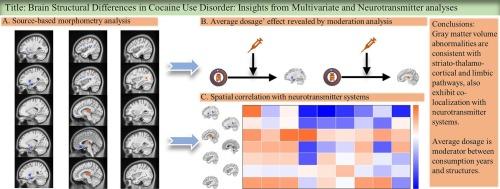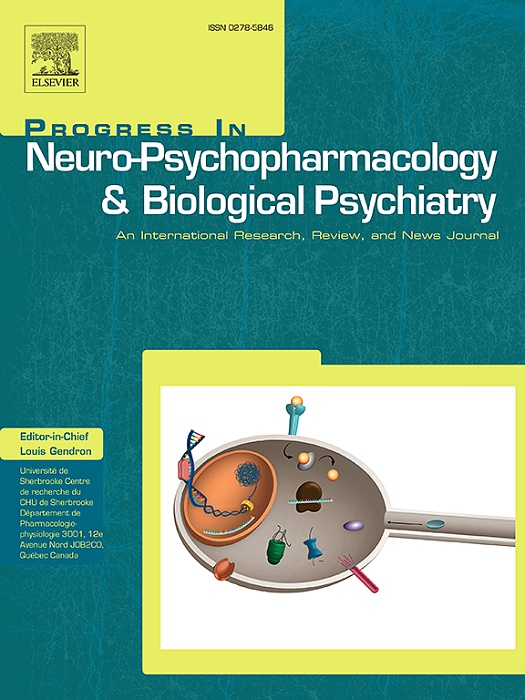可卡因使用障碍的大脑结构差异:多变量和神经递质分析的启示。
IF 5.3
2区 医学
Q1 CLINICAL NEUROLOGY
Progress in Neuro-Psychopharmacology & Biological Psychiatry
Pub Date : 2024-10-02
DOI:10.1016/j.pnpbp.2024.111159
引用次数: 0
摘要
可卡因使用障碍(CUD)是一种慢性复发性神经精神疾病,以大脑结构和功能性病变为特征,对公共卫生构成重大挑战。虽然可卡因对神经递质系统(受体/转运体)的破坏作用已被充分证实,但 CUD 的脑结构异常模式及其与其他因素的相互作用仍是一个持续的研究课题。我们对 50 名 CUD 参与者和 50 名来自公共 SUDMEX CONN 数据集的匹配健康对照者采用了基于源的形态测量法(SBM),这是一种多变量方法。这种方法使我们能够识别脑组织体积差异的共变模式,并通过调节分析进一步探讨可卡因平均剂量的影响。我们还进行了空间相关性分析,以研究组织体积变化与多巴胺和血清素化学结构分布之间的微观-宏观结构一致性。我们的 SBM 分析结果与纹状体-眼球-皮质和边缘通路中与奖赏相关的神经适应一致,并且还显示出与多巴胺和血清素系统分布的共定位。节制分析表明,平均剂量正向加强了可卡因消费年限对大脑结构的影响。通过整合我们对灰质和白质体积差异以及相应神经递质分布的发现,这一综合观点不仅加强了我们对 CUD 脑结构异常的理解,还揭示了其发展和恶化的潜在机制。本文章由计算机程序翻译,如有差异,请以英文原文为准。

Brain structural differences in cocaine use disorder: Insights from multivariate and neurotransmitter analyses
Cocaine use disorder (CUD) is a chronic and relapsing neuropsychiatric disorder characterized by structural and functional brain lesions, posing a significant public health challenge. While the disruptive effects of cocaine on neurotransmitter systems (receptors/transporters) have been well established, the patterns of brain structural abnormalities in CUD and its interaction with other factors remain an ongoing topic of investigation. We employed source-based morphometry (SBM), a multivariate approach on 50 CUD participants and 50 matched healthy controls from the public SUDMEX CONN dataset. This method allowed us to identify co-varying patterns of brain tissue volume differences, and further explore the effect of average cocaine dosage through moderation analysis. Spatial correlation analysis was also performed to examine micro-macro structural consistency between tissue volume variations and chemoarchitectural distribution of dopamine and serotonin. Our SBM analysis findings were consistent with reward-related neuroadaptations in the striato-thalamo-cortical and limbic pathways and also exhibited co-localization with the distribution of dopamine and serotonin systems. The moderation analysis suggested that the average dosage positively strengthens cocaine consumption years' effect on brain structures. By integrating our findings of gray and white matter volume differences and corresponding neurotransmitter profiles, this comprehensive view not only strengthens our understanding of the brain's structural abnormalities in CUD, but also reveals potential mechanisms underlying its development and progression.
求助全文
通过发布文献求助,成功后即可免费获取论文全文。
去求助
来源期刊
CiteScore
12.00
自引率
1.80%
发文量
153
审稿时长
56 days
期刊介绍:
Progress in Neuro-Psychopharmacology & Biological Psychiatry is an international and multidisciplinary journal which aims to ensure the rapid publication of authoritative reviews and research papers dealing with experimental and clinical aspects of neuro-psychopharmacology and biological psychiatry. Issues of the journal are regularly devoted wholly in or in part to a topical subject.
Progress in Neuro-Psychopharmacology & Biological Psychiatry does not publish work on the actions of biological extracts unless the pharmacological active molecular substrate and/or specific receptor binding properties of the extract compounds are elucidated.

 求助内容:
求助内容: 应助结果提醒方式:
应助结果提醒方式:


